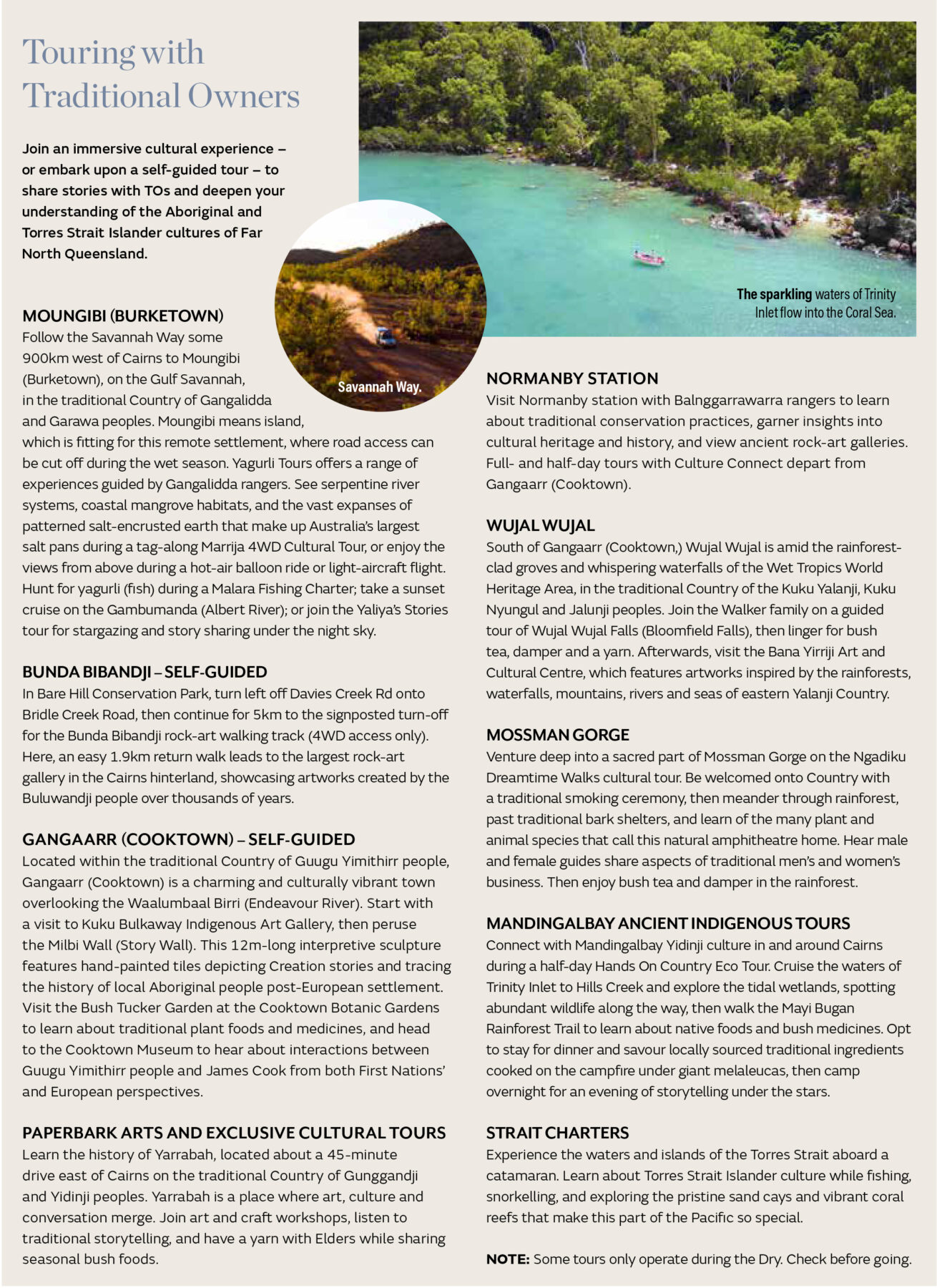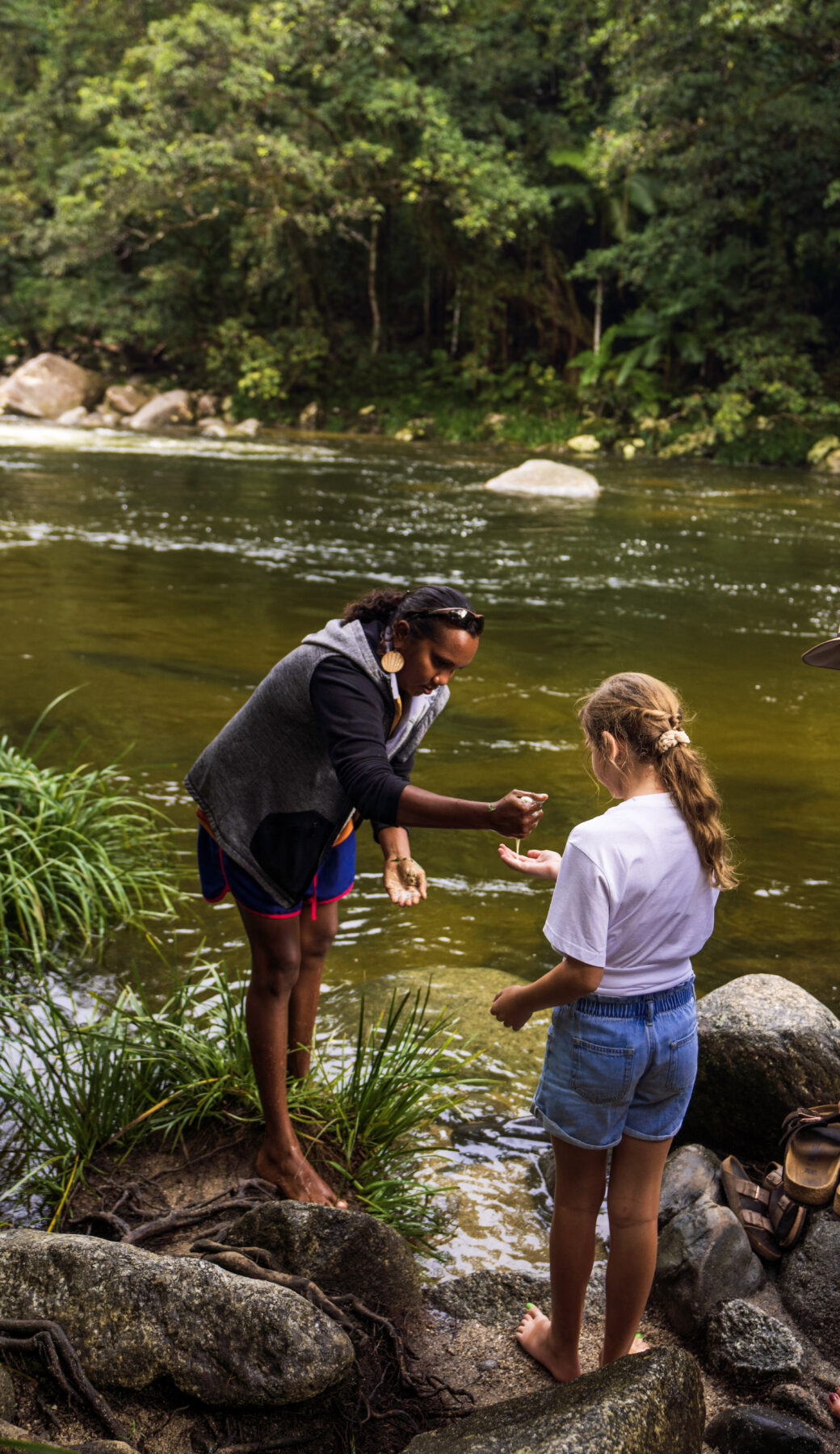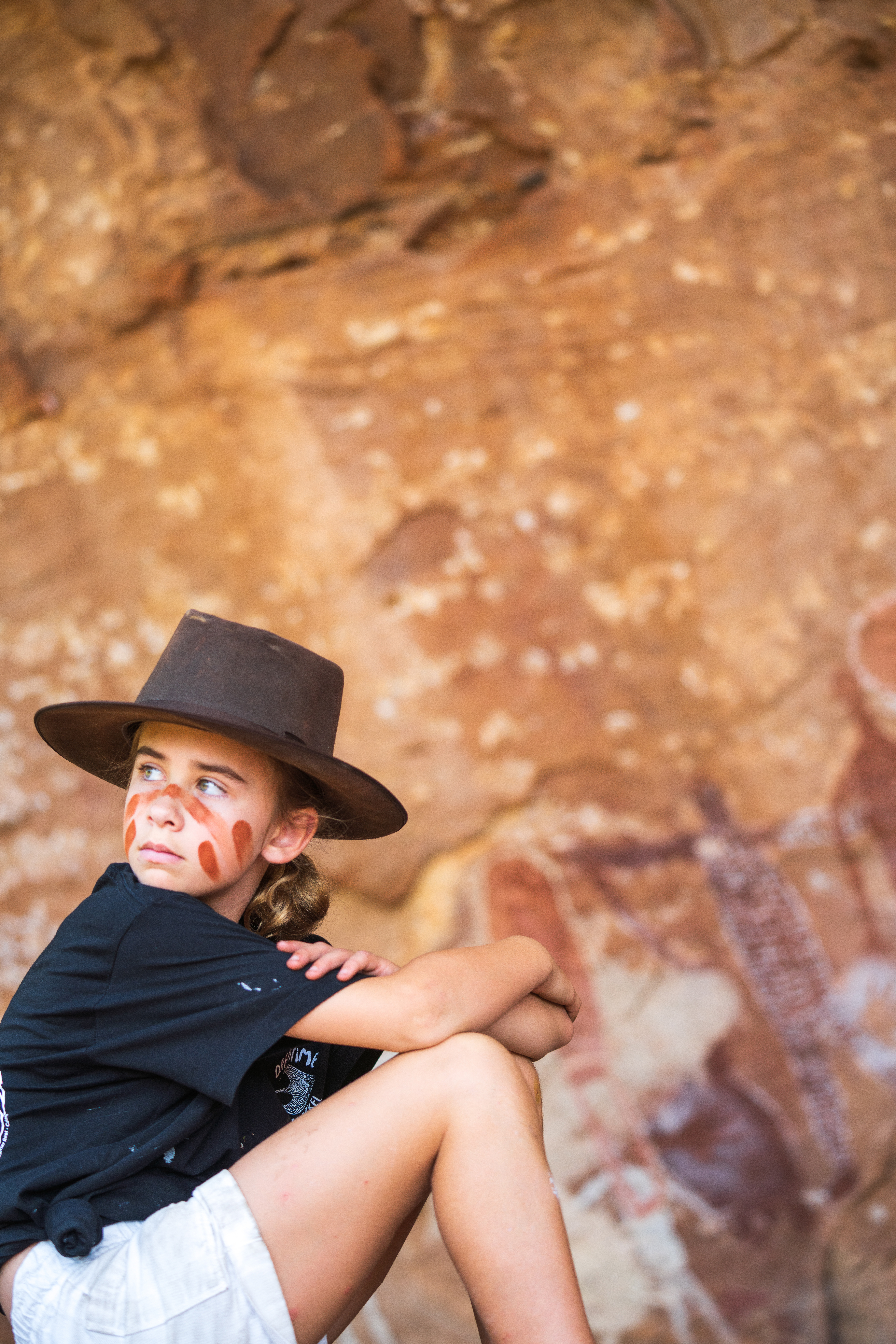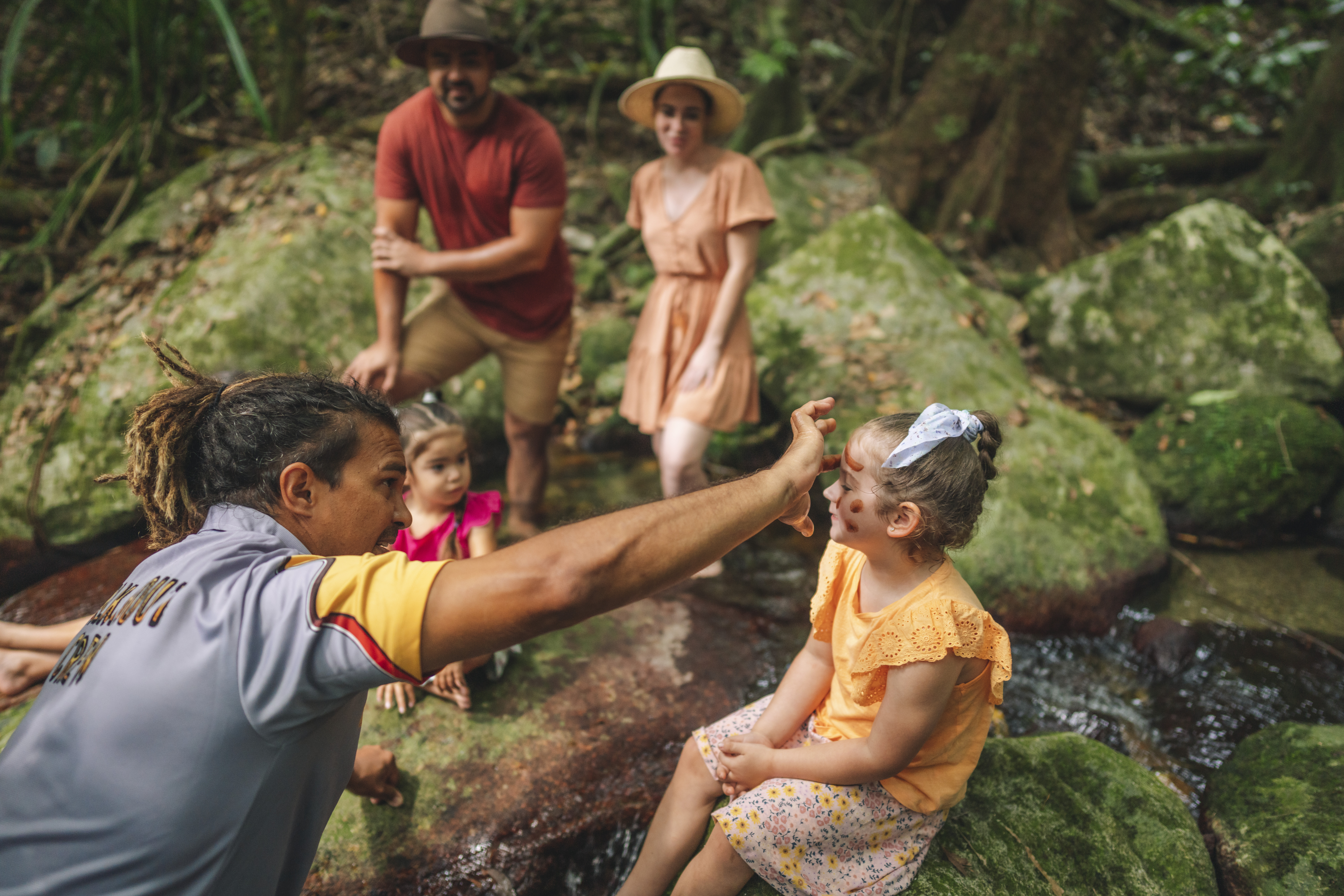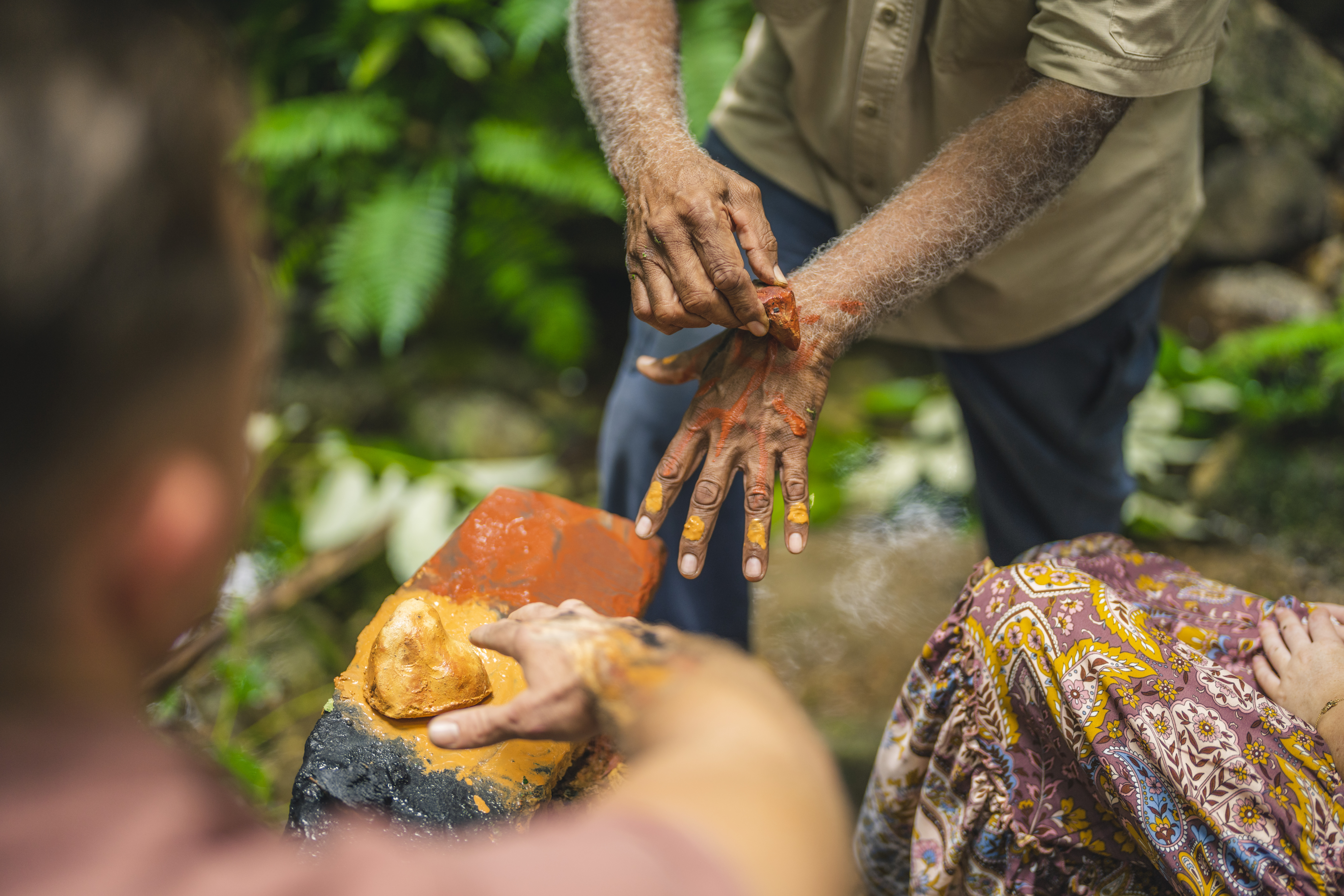Thundering in a hulking mine-spec truck into the tiny township of Laura, roughly a 320km drive north-west of Cairns, in Far North Queensland, seems excessive at first but I soon understand the need for such grunt. On leaving the bitumen, we venture south-west into the eastern corner of the Cape York Peninsula along the formidable heritage-listed Laura to Maytown Coach Road. It’s revered as one of Australia’s toughest four-wheel-drive tracks, but to Kuku Yalanji Traditional Owner (TO) Johnny Murison, it’s the route of his twice-weekly commute. “We call it the ‘Thousand Dollar Track’, because that’s what you’ll need to fix your car after you drive it,” he says, laughing.
Johnny guides tours into Western Yalanji Country, which forms part of Quinkan Country, with his company Jarramali Rock Art Tours. From Laura, it takes about an hour and a half to reach Camp Jarramali, where we will be based for the next two days. The final 10km is particularly rough and slow going. The landscape buckles and folds around us as we weave through Quinkan Country, past rugged tangles of savannah and the stands of desert bloodwood, stringybark, ironwood and melaleuca trees that skirt the towering sandstone escarpments nearby.
Johnny calls out to his ancestors as we approach Western Yalanji Country, which stretches from the headwaters of the Palmer and Mitchell rivers to lands surrounding Laura, and is home to 26 family groups from 10 clans. It covers about 7610sq.km in total and forms part of the larger footprint of exclusive and non-exclusive native title and freehold land that makes up Quinkan Reserve.
“To inspire cultural understanding, I welcome visitors to see Country through my eyes as a TO,” Johnny says. He explains that although native title exists over most of Western Yalanji Country today, times were very different for his ancestors, many of whom endured indelible suffering and were forcibly removed from Country. “I share our truth and honour the fight our people put up to stay on Country where they belonged, but I do so with compassion and grace over venom,” he says.

We are officially welcomed to Western Yalanji Country in traditional language. “Jarramali translates as thunder in Kuku-Yalanji language,” Johnny says. “It’s a commanding sound that gets everyone’s attention.” It’s not until we reach Camp Jarramali that I truly sense the word’s significance. The campsite is pin-dropped on the periphery of a vast sandstone escarpment. From here, it peers into deep ravines where the braided tributaries of the Mossman River etch across the landscape some 70m below.
Wulburjulburr (the Great Dividing Range) runs like a spine through Quinkan Country. Beyond, Rinyirru (Lakefield) National Park lies to the north-east, and the Koolburra Plateau to the north. It’s awe-inspiring country, tucked into a pocket of what is regarded as one of Australia’s most remote frontiers. Although the region is known, post-colonisation, for being the site of Queensland’s largest gold rush – alluvial gold was discovered near the Palmer River in 1873 – it is now recognised and celebrated for the richness and scale of its rock-art deposits. There is evidence of Aboriginal occupation here tracing back more than 34,000 years, and the region is home to one of the largest assemblages of prehistoric rock art on the planet. UNESCO considers Quinkan Country to hold one of the 10 most significant collections of rock art in the world. Spread across numerous sandstone galleries, the art includes stencils, paintings and engravings, or petroglyphs, many in the figurative style. It’s a dynamic cultural landscape, where collaborations today between TOs and researchers are linking the past with the present, providing valuable insights into historical patterns of human occupation in Australia.
“You’re in the penthouse,” Johnny says jokingly as he motions for my young daughter and me to follow a trail of stepping stones to the furthest reach of the escarpment, where a sole tent billows in the wind. Inside, there’s a simple double camp stretcher. Outside, the vista is a junction of snaking rivers that burrow through deep gorges in the time-worn landscape. In the afternoon light, craggy rock faces glow rose-gold, and deep within their creases, we glimpse pockets of remnant ancient Gondwana-descendant rainforest.
Sections of the Quinkan Reserve form part of the Wet Tropics Bioregion, which stretches along Australia’s north-eastern coast between Townsville and Cooktown for roughly 450km and covers a total area of almost 20,000sq.km. These sections have been identified as an important biotope for plants, marsupials and songbirds. Rare and endangered species include the large-eared horseshoe bat and the squatter pigeon – both of which are currently listed as vulnerable under the federal Environmental Protection and Biodiversity Conservation Act 1999 and endangered under Queensland’s Nature Conservation Act 1992.
Adding to the penthouse’s allure, a rock ledge has been added where water naturally flows down the escarpment, giving guests a unique infinity pool experience. “When it rains, it’s magic,” Johnny says. Close by are a communal shelter, campfire, yarning circle, and private bathroom with rainwater shower. Surprisingly, the toilet, which is located a little further up the path, has no door. “Why would you shut out that view?” Johnny says.
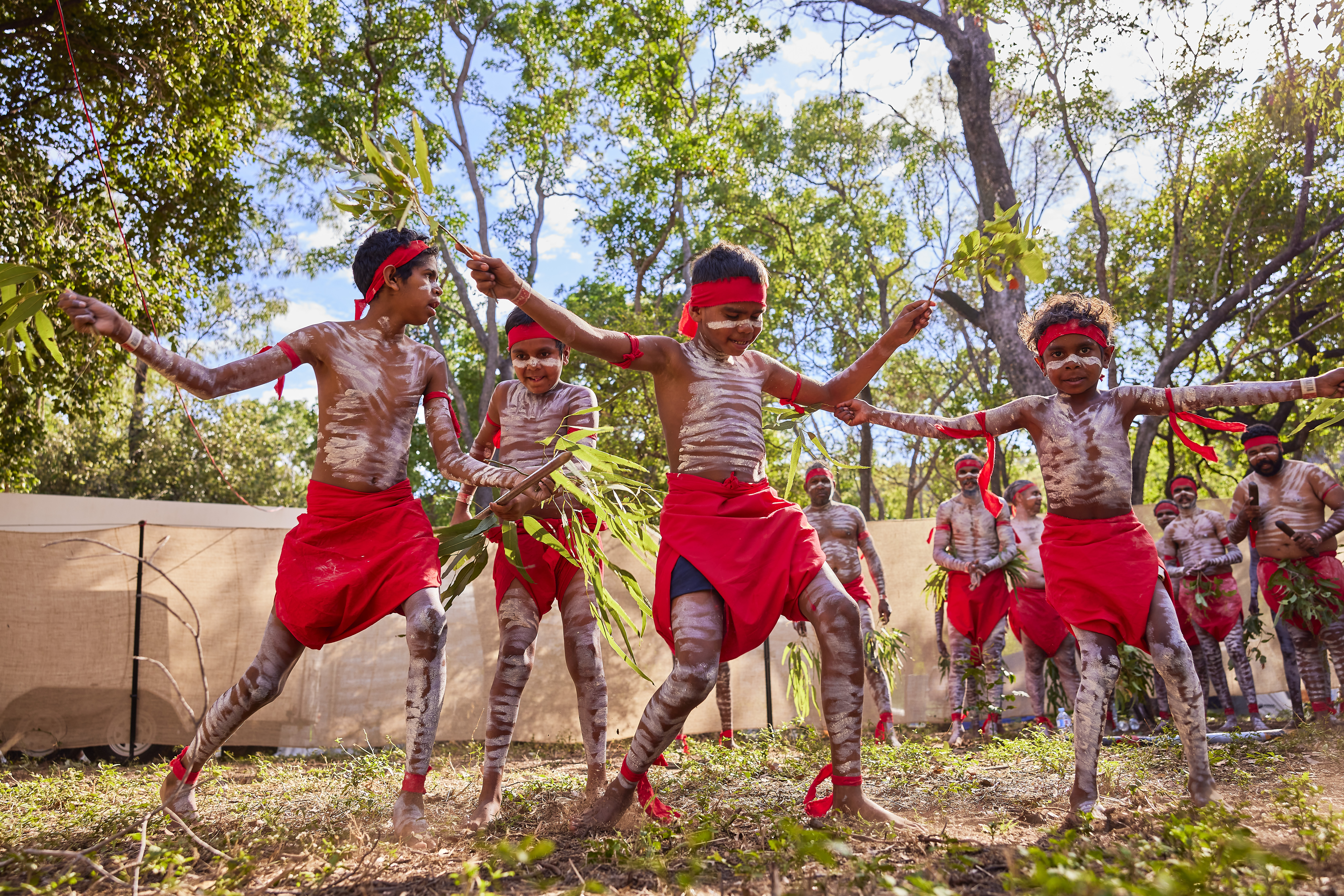
Johnny started Jarramali Rock Art Tours in 2016, after leaving his job as a Seventh-day Adventist pastor in Cairns to return to Country. It was a decision the Elders welcomed. “They are very proud of us, and [were] in tears when they saw what we were doing here at Jarramali,” Johnny says. “Our goal is for guests to leave as better versions of themselves because they have spent time with us on Country.” Sharing his culture and connection to Country is important to him, but for Johnny there are other benefits to being back on Country as well. “Caring for Country is always the priority, but the opportunity to grow a sustainable business here that employs other Aboriginal people is a chance to move forward into a future we can continue to shape as our own,” he says.
During the tour – operating between 1 May and 1 October 2023 (weather dependent) – our daylight hours are spent following Johnny through the bush, listening to his unscripted musings, thoroughly engrossed in everything he shares. His knowledge is intuitive. Stopping regularly as if perusing shelves in a shop, he collects sap from a bloodwood tree and crumbles it into our hands, describing it as a powerful antiseptic for scalds, infections and wounds. Crushing the leaves of the turkey bush to release its camphor-like fragrance, he explains it’s an excellent mosquito repellent when rubbed directly onto the skin or added to a fire. We also learn about some of the many uses for melaleuca; the bark can be used to wrap roasts for a campfire and the leaves can be brewed into a tea that offers a soothing remedy for sore throats.
We are constantly challenged physically. Always bounding ahead, Johnny almost goads us to keep up. My nine-year-old daughter rallies, scampering down tracks worn bare by wallabies and rock-hopping before plunging into crystalline freshwater pools and getting pummelled by rain-fed waterfalls. We are invigorated by this wondrous playground and encouraged to simply explore, feel and connect.
Our final hike winds us down an earthen track scoured beneath the escarpment our camp sits atop. Here, Johnny introduces us to the aptly named Magnificent Gallery, a 7m x 40m rock shelter that features some 450 works of art on its underside, some as old as 20,000 years.
“I still get goosebumps every time I visit, knowing it was my ancestors that immortalised my cultural heritage in ochre on these walls,” Johnny says. Once we’re inside the gallery, he shares stories about his ancestors, guiding us through a rich tapestry of lore, spirituality and culture, all underpinned by the common thread to respect and honour Country.
Exquisitely preserved, intricate and hauntingly beautiful, the paintings portray ethereally tall, long-limbed spirit beings known as quinkan, slender spirits known as timara, and malevolent, fat-bodied spirits known as imjim. There are animal totems, as well as depictions of people wearing elaborate ceremonial dress, which indicates they were of high social standing, explains Johnny. The presence of many animal figures, including walkarr (goanna), kudi kudi (barramundi), ngujay (turtles) and julmbanu (kangaroos), indicates food sources would have been plentiful here. My daughter points to a series of small handprints, similar in size to her hands, lining the wall base. Johnny draws a connection between these prints and the fertility symbols depicted above. He says that for his maja bama (ancestors), having many children was a blessing.
“It connects me to this Country to know my family were here and it’s my responsibility to learn the meanings behind every one of the 450 or so figures,” Johnny says. The remote nature of the country here means that before he stumbled upon this site in 2016, very few people had visited in recent times. It is believed there are more than 10,000 other galleries in the area, and Johnny claims to discover new art sites every other day he’s on Country.
Upon our return to camp, we learn Western Yalanji rangers are burning Country close by. My daughter is thrilled to be invited to watch. We learn that fire has been used here for millennia by Indigenous custodians to guard, nurture and protect Country. Mesmerised, we watch flames flicker through the undergrowth. The sound is melodic. Thin veils of pure white smoke dance evocatively up into the night air. The rangers tell us controlled, cool fires move slowly and produce less smoke than bushfires, safeguarding tree canopies so birdlife remains preserved and allowing animals to easily escape.
The rangers are careful to preserve rather than raze the landscape – the flames barely reach knee height before they burn out. This stimulates the recovery process of plants, and the new shoots and regrowth provide nutritious food sources for animals.
“Reducing weeds and fire load while promoting new growth in native grasses and shrubbery is our primary goal for burning, but healthier wildlife means better bush tucker, and their population recovers quickly when they are eating well too,” says ranger Nathaniel Durickawai Tanna (Archie). “Caring for Country is about preserving all native life so the natural cycle continues and Country stays strong.”
It’s a fitting end to our time on Country, where we’ve felt our energy rise and our spirits swell. My daughter has glowed under Johnny’s tutelage, and he tells us that being here, openly learning about his culture, means we are family now too, which delights her.
Wearing ochre painted on her face by Johnny as a symbol of belonging, she dances freely around the campfire as he plays the didgeridoo. Johnny is an awarded musician, as well as an author, speaker, pastor, ranger and conservationist. There doesn’t seem to be much he can’t do. But while he is often sought after for his multiple vocations, he tells us he feels most at home here, on Country, at his “5-billion-star hotel”.
KUKU YALANJI COUNTRY
Kuku Yalanji Traditional Custodian Karanba (Garunbah) Juan Walker has called UNESCO World Heritage-listed Madja (the Daintree Rainforest) home his whole life. Madja begins about 70km north of Cairns, then runs north along the coastline for roughly another 70km, encompassing some 1200sq.km in all.
Juan has worked as a guide here for close to 20 years, sharing his knowledge of, and insights into, the cyclical nature of the oldest continually surviving tropical rainforest on earth from a perspective passed down from his marri-marri (ancestors). He started his own business, Walkabout Cultural Adventures, in July 2008. He guides half- and full-day small-group tours through eastern Kuku Yalanji Country and has a strong focus on training other local Aboriginal and Torres Strait Islander people to guide, as it connects them to Country and helps preserve culture. “It’s always more valuable to hear cultural stories from the people they belong to, but also gain an understanding of their connection to this Country firsthand,” he says.
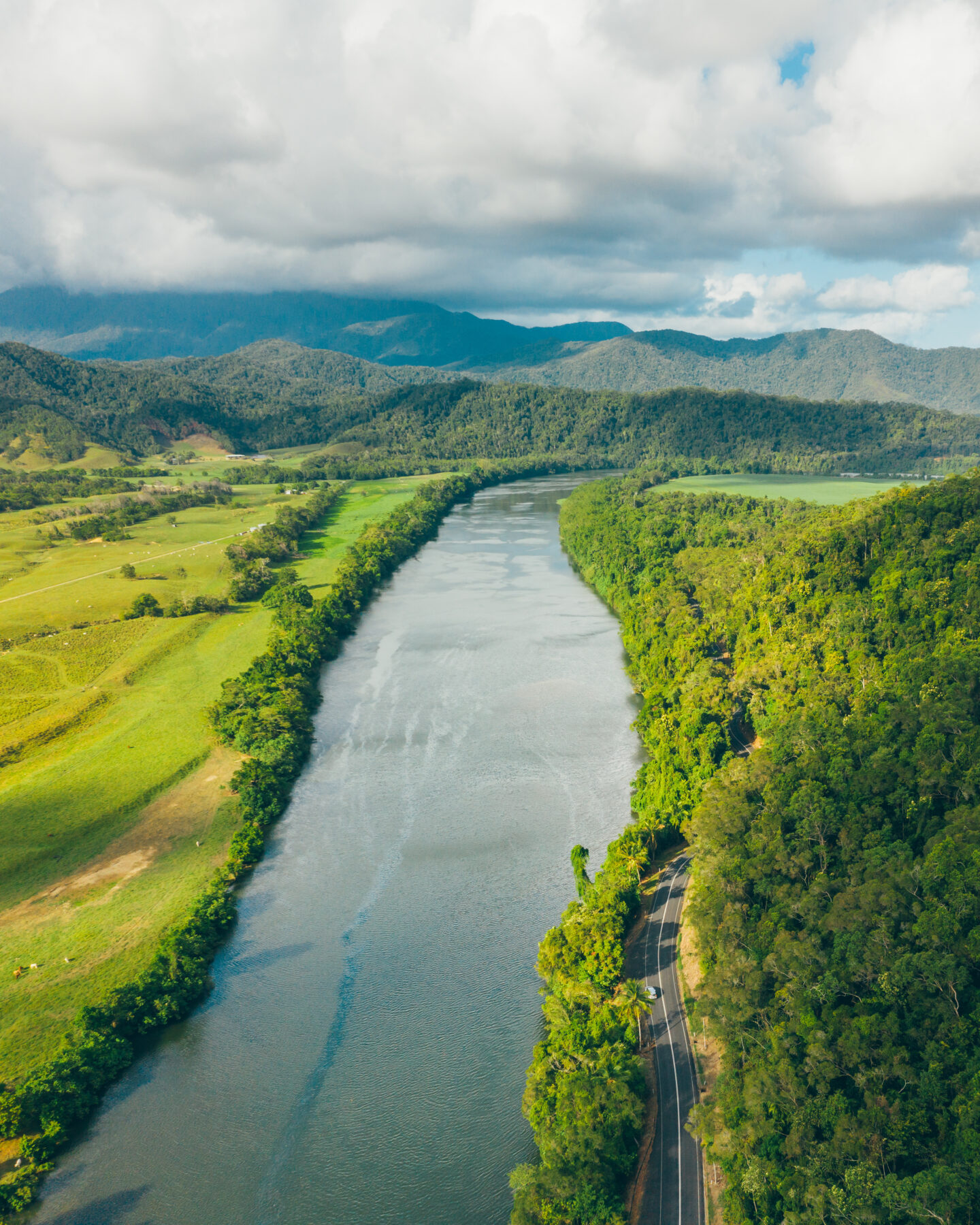
We join Juan in Jinkalmu (the Mossman area), before reeling through a ribbon of back roads, through thick tracts of rainforest interwoven with cane farms and fruit orchards, en route to Julay (the Daintree River).
Along the way, we stop to sample roadside bush tucker. At one point, this involves provoking a nest of angry yangka (green ants) so we can lick their vitamin C-rich abdomens. At another point, we stop to try the sweet, rose-like petals of wawuburra (native hibiscus). We spot saltwater bilngkumu (crocodiles) basking on the banks of creeks; we weave through creek and mangrove habitats; and we gather beside landmarks to hear stirring Creation stories of how the Country here has been shaped according to Kuku Yalanji Dreaming.
It’s a landscape Juan is intrinsically and deeply connected to. Kuku Yalanji heritage dates to some of the earliest known human occupation in Australia, some 50,000 years ago. Juan’s father is Kuku Yalanji and his mother is of Torres Strait Islander descent. As part of both the Rainforest and Saltwater peoples, he lives in spiritual, cultural and physical synergy with both the land and sea.
When we arrive at Kuyu Kuyu (Cooya Beach), the arced sweep of coast Juan calls home, we find coconut groves fringing the sea and a rich cluster of mangroves that has long been an abundant hunting ground.
The term Kuyu Kuyu means “many fishes”. We learn that the nutrient-rich waters of the Mossman River empty here, flowing out into the Coral Sea. Juan learnt to hunt here and today we will too, using kalka (spears) to catch our own lunch. We wade into the ankle-deep water with Juan in search of mud crabs.
He points to a cloud of sand and tells us it indicates a crab is on the move. We strike at the sand, trying to locate the crab, but our efforts yield no result. Juan suggests we move closer to the mangrove habitat to try something a little easier to master. The labyrinth of mangrove roots is the perfect place for mottled periwinkles, semi-translucent butterfly pearls and mussels to hide.
We gather as many as we can comfortably carry and return to the beach, where Juan prepares a delicious, stir-fried seafood lunch. “We have always only taken from the land and the sea what we can carry and consume directly,” he says. “This way, the ecosystem remains sustained.”
We leave our empty shells close to a midden nearby. Juan tells us this has a dual purpose: it lets others know what’s been taken and is a way of honouring conservation.
For our final stop, we return to the rainforest to visit Mossman Gorge. Deft at spotting wildlife, including the shy jalbil, also known by the common name Boyd’s forest dragon, Juan demonstrates the myriad ways Kuku Yalanji people have lived harmoniously within their rainforest environment.
“People usually tell us that they are amazed by how we still [connect] with Country in our modern world, but it’s a connection we have learnt from our Elders, who in turn learned from theirs over a history spanning thousands of years,” Juan says.
My daughter explores the landscape, making bush soap from leaves of the karandal (red ash) and painting her face and arms with ochre. Juan shows her how to use a smoothed rock plucked from a stream to grind soft rocks from waterways into a paste.
“We are a part of the rainforest, and it is a part of us,” Juan says. “When people engage and connect with our culture, they leave with a new appreciation for our lifestyle, for how we have adapted to modern living, and, more genuinely, how to care for and respect Country. These are simple principles people can take away and easily apply to their own lives.”
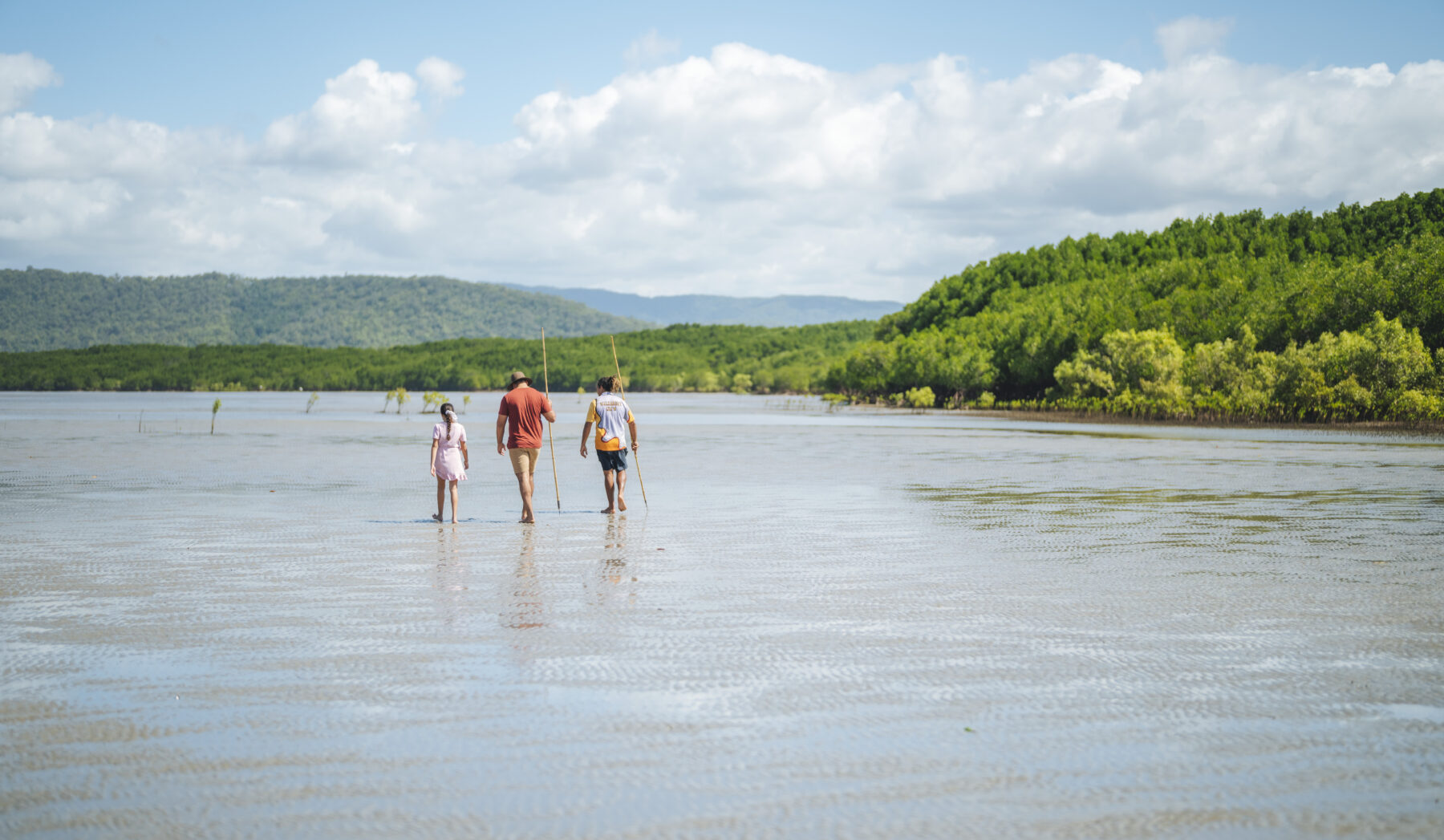
EWAMIAN COUNTRY
Deep in the heart of Queensland’s Gulf Savannah, in a seemingly endless sweep of remote golden grasslands, a muddle of eucalyptus and acacia trees shrouds an ancient geological wonder that’s been bubbling away for millions of years. Located about 360km south-west of Cairns, Talaroo Hot Springs is revered as a natural phenomenon of outstanding geological significance. For millennia, it’s been an important place of spiritual, physical and cultural significance to TOs, the Ewamian people.
TO and general manager of Ewamian Limited Sharon Prior says the 2021 launch of cultural and ecotours at Talaroo Hot Springs and the opening of the camping ground and caravan park was the culmination of many years of planning, dedication and determination by Ewamian people.
Ewamian people were dispossessed of their homelands in the late 19th century to make way for the expansion of European settlement. Talaroo holds significant cultural values for Ewamian people and was one of the many properties where they worked as stockmen or domestic help in order to maintain cultural connection to their ancestral lands.
The hot springs were first discovered by Europeans as far back as 1864, and the Jardine Brothers camped not far away with their cattle at Cawana Lake on their journey to Cape York. In 1888 Talaroo Hot Springs (formerly known as Ambo Springs) became a horse change station on the Cobb & Co. trail to Georgetown.
Passengers would soak in the thermal waters to heal their weary bodies before continuing on their journey.
Talaroo, a 31,500ha pastoral property, is now owned and managed by Ewamian people as an Indigenous Protected Area and Nature Refuge. It was purchased in 2011 through the National Reserve System (NRS) by the Indigenous Land and Sea Corporation (ILSC). Ewamian rangers are employed to manage the property to ensure that the natural and cultural values are protected.
“Maintaining a physical and spiritual connection to these lands, waters and our culture, and allowing future generations to walk in the footsteps of our ancestors, was both a vision and dream we’ve long held,” Sharon says. “In returning to Country to live and work, the opportunity to showcase Ewamian hospitality, and create economic, conservation and community-based opportunities through employment, is shaping a better future for Ewamian people.”
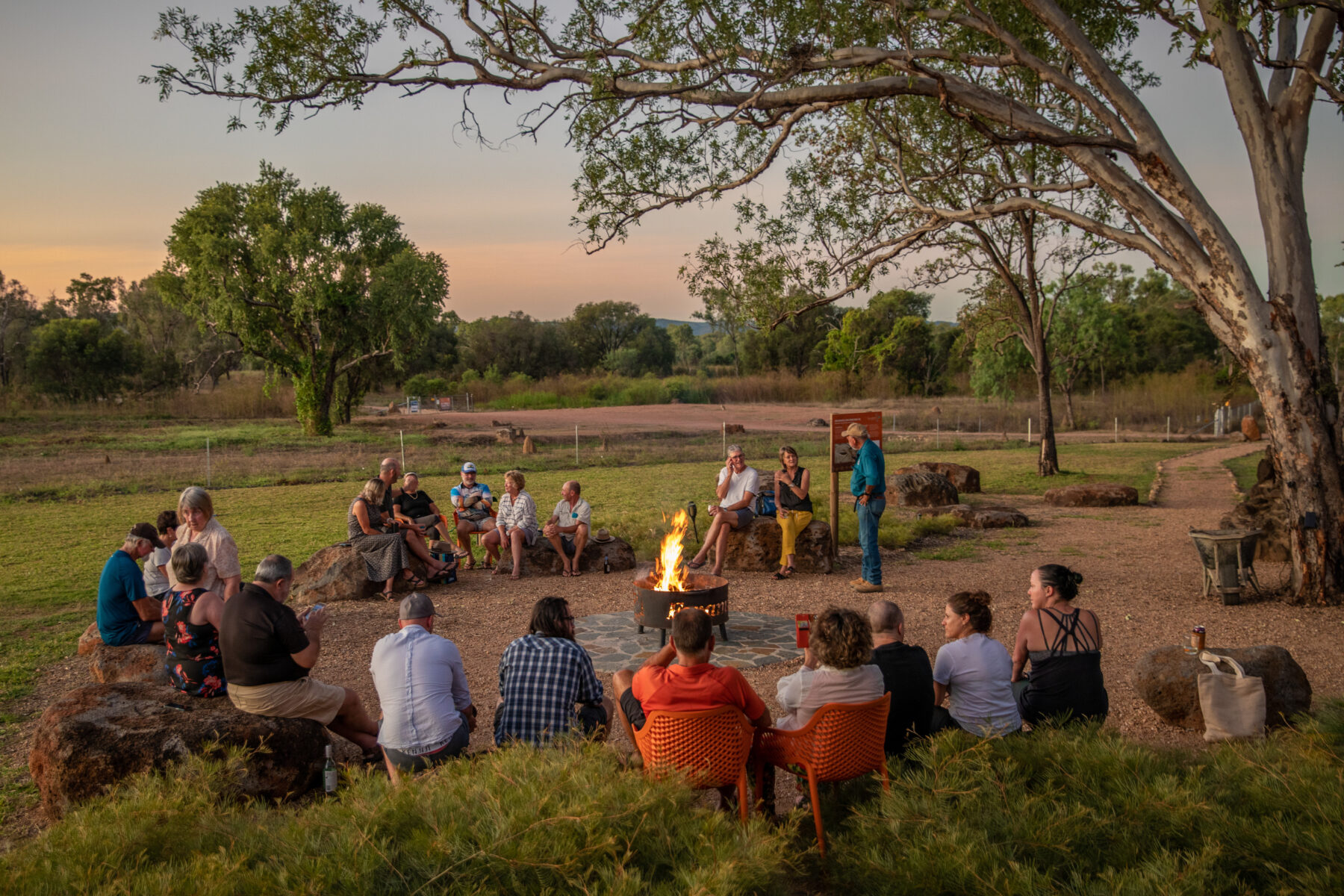
We visit the springs with Ewamian Elder Jimmy ‘JR’ Richards. His return to Country represents his own full-circle journey. As a young man, he worked at Talaroo as a stockman. He is now a ranger and tour guide. “TOs are proud to share what we have here: an incredibly powerful place for spiritual and physical healing,” he says.
Ewamian Country extends through the Gulf of Carpentaria savannah in the upper Gilbert and Einasleigh rivers catchments and includes the townships of Georgetown, Forsayth, Einasleigh and Mount Surprise – an area spanning roughly 29,000sq.km. It’s a region rich in rock art, scar trees, occupation sites, bora and ceremonial grounds, and groove stones can be found in most rivers and creeks.
JR leads us onto an elevated boardwalk above the springs. From here, we see the hot springs’ true beauty. More than 800sq.m of mounded travertine terraces cascade across the earth, etching the landscape with intricate patterns and providing bursts of vivid colour to the otherwise neutral scene. The springs support a rich ecosystem of plants and animals and is an important water source for wildlife. It contains unique habitats for a variety of living organisms, including a recently discovered species of cyanobacterium, as well as an ostracod (tiny shrimp) found only in water over 45°C and an endangered succulent, the salt pipewort.
“At their hottest point, the springs bubble up from the earth at 62°C,” JR says, explaining that they are the result of rainfall on the nearby Jorgensen Ranges seeping deep within the earth to collect over a period of up to 20,000 years. “Geothermal forces heat the water and return it to the surface via the springs, which cool slowly as they trickle down through the series of mounds, forming a life-supporting oasis.”
The springs hold secrets from the past. JR points out, entombed in the travertine, the jaw of a carnivorous kangaroo thought to have roamed up to 20,000 years ago when megafauna were present in the area.
“A guided interpretive tour is the only way to access the springs,” JR says. This ensures Ewamian culture is sensitively shared and the site is protected for future generations. The tour includes a soak in the communal springs pool, or a smaller private pool that can be booked for an extra fee. We choose the latter and spent an idyllic 90 minutes soaking in the mineral-rich waters where the temperature can naturally vary between 28°C and 40°C. There are camping and glamping facilities onsite, as well as a cafe, shop, yarning circle and fire-pit area. In 2023 the springs will be open from 1 April to 1 October; access is weather dependent. There are plans for expansion and a storytelling room to be added, where Ewamian people will be able to share their stories and culture, in the hope of inspiring further healing and reconciliation. “We want to share with non-Indigenous people the spiritual relationship that Ewamian people hold and the complexity that exists in our connection to Country,” Sharon says.
“When I was a young woman, no job on my Country would have recognised me as a TO,” she says. “It’s great there is positive change occurring within Australia to embrace Indigenous people as TOs through our determination to honour our ancestors, Elders, ourselves, culture and our Country.”
